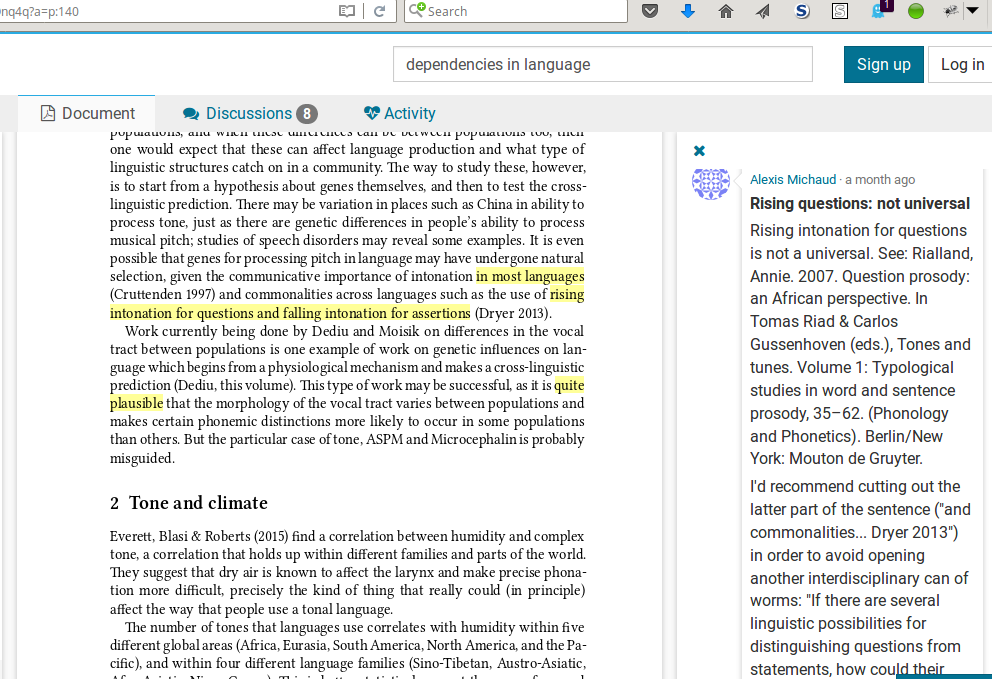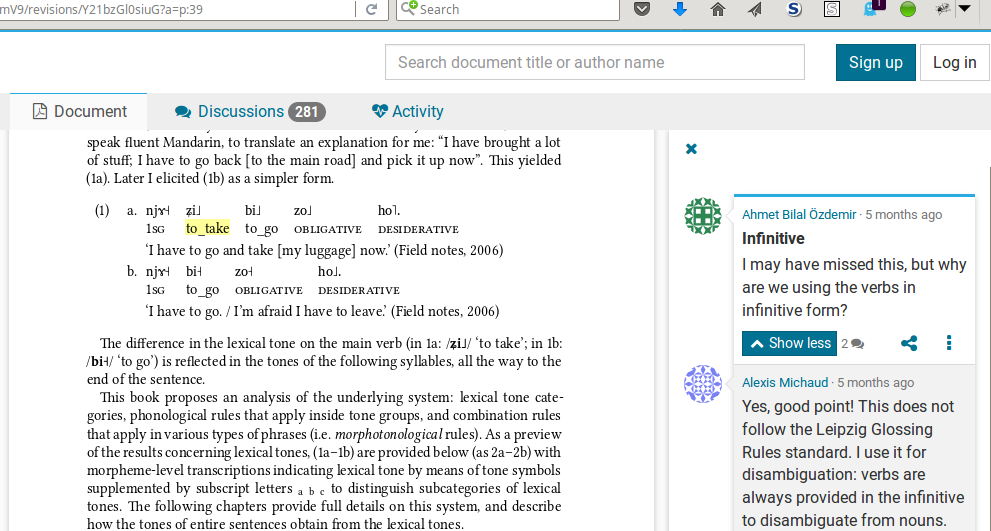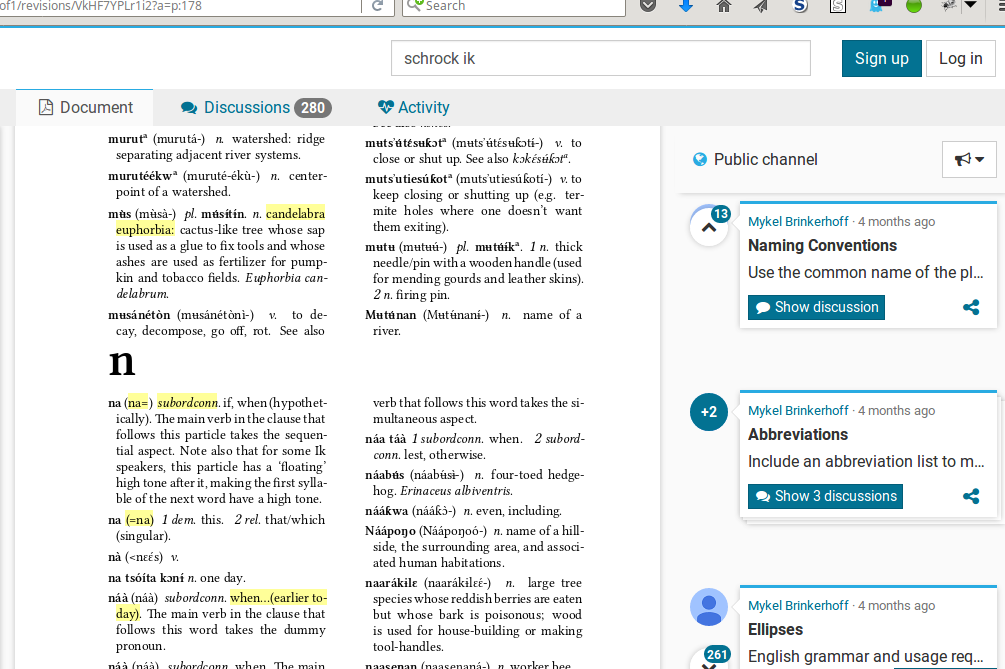Traditionally, once a book was published, there was little you could do to change its content afterwards. Works in linguistics which see a second edition are few and far between. The most you could hope for is a sheet of errata distributed with the book itself. One consequence of this was, incidentally, that many works were withheld for a long time to make sure they were absolutely perfect before releasing them to the printer’s, which would make the content immutable.
With electronic publication, things are different. The publication of a new version is comparatively cheap. In this blogpost, I will detail the lifecycle of a document at Language Science Press and show how we work together with PaperHive to get the document from the initial stage to the first (and subsequent) editions. At the end, I will put this approach into a wider perspective on academic publishing.
The initial submission of a manuscript differs from the final published version. We can distinguish 5 different phases a manuscript can be in:
| 1) Initial submission | |
|
(Open) review |
|
|
2) Accepted version |
|
|
Community proofreading |
|
|
3) Proofread version |
|
|
Typesetting |
|
|
4) Typeset version = first edition |
|
|
Post-publication comments and errata |
|
|
5) Second edition |
|
Submission ⇒ accepted version
At Language Science Press, we have optional Open Review. There are many definitions of Open Review. In the context of this blogpost, Open Review means that a preliminary version of the title is available for anybody to comment on. This is realized via PaperHive and GitHub pages, where we host the preliminary version. For instance, Tone in Yongning Na was available for Open Review in early 2017. Ahmet Bilal Özdemir, who was not selected by Language Science Press, left a number of comments on that version.
While this proves that the technical setup works, it is clear that in order for Open Review to take off, much more must be done in order to build up a larger user base which will take the time to read the book thoroughly and leave in-depth comments.
Accepted version ⇒ proofread version
At Language Science Press, acceptance typical is conditional upon attending to a list of suggested changes. Once the submission is revised according to the reviewers’ suggestions, the manuscript reaches proofreading stage. Proofreading is done via the community. At the time of writing, we have about 250 community proofreaders, who are informed about a new book being ready for proofreading. Typically, about 20 people volunteer, who each take one or several chapters. As an example, we can take this dictionary with grammar sketch of the Ik language (still called Icétôd at that point of the process). In total, 279 comments were left on the proofreading version, which were then incorporated for the published version. The comments concern style, readability, English usage or adherence to particular guidelines.
Proofread version ⇒ typeset version (= first edition)
This is done at the LangSci office. There is no trace of this on Paperhive.
First edition ⇒ subsequent editions
Once the book is published, we make it available on our website, but also on a number of other venues (GoogleBooks, Github, Zenodo, OAPEN, PaperHive). On PaperHive, it is possible to leave comments on the published version of books. There are two main use cases for this: Errata and discussion points.
For The Alor Pantar languages we tracked errata on Paperhive and incorporated them in the second edition. Other books with errata include The Ik language and Grammatical theory.
The real goal of PaperHive, however, is to stimulate discussion about a book and to provide additional perspectives. First instances of this can be seen on Dependencies in languages where 8 comments have been left relating to various issues raised by the book.

Additional insights provided after publicationby a reader, Alexis Michaud, not part of the original editorial team.
Evaluation
The phase from accepted version to proofread version, i.e. Community Proofreading, can be considered well established, and we have had manuscripts with more than 1000 comments by more than 15 people. As for Open Review, Errata, and Post-Publication Commentary, there has been less activity. The possible cause for this is that the goal of the interaction in those cases is less clear circumscribed as compared to “read chapter 4 and note anything which is in conflict with the guidelines”.
From monoliths to more fluid forms of publication
In former times, the publication of a printed book was the keystone of a research enterprise, which concluded many years of labour in amassing data, structuring it and putting it into prose. With the advent of electronic publication, this telic approach, with a fixed objective “publication” shaping the research process, is beginning to erode. Presentation of preliminary results is becoming more common, and input from peer researchers early on in the process is requested and provided.
https://twitter.com/Protohedgehog/status/821730331866775552
This more fluid (and more collaborative) nature of scientific communication where we are heading to does not agree too well with the traditional recipe of publishing monolithic books. In this blogpost I hope to have shown that by making preliminary versions available for comment on a platform like PaperHive in a structured way, and by keeping a history of the different interlinked versions, the format “book” can actually be very well integrated into an electronic and collaborative publishing landscape.




